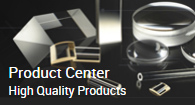Application Range and Manufacturing Method of Cylinder Lenses
Application Range:
Cylinder lenses, a type of non-spherical lens, are primarily used to effectively reduce spherical and chromatic aberrations. They find application in changing the design requirements for image size. For instance, they can transform a point light spot into a line spot or alter the height of an image without changing its width. Cylinder lenses are commonly utilized in applications such as linear detector illumination, barcode scanning, holographic illumination, optical information processing, computers, laser emission, and more. They also have extensive use in high-precision testing instruments and devices like high-power laser resonator mirrors and long-distance interferometers.
Manufacturing Method of Cylinder Lenses:
The production process of cylinder lenses involves rough grinding, fine grinding, polishing, and centering.
-
1.Rough Grinding of Cylinder Lenses:
-
For small-radius cylinder lenses, the rough grinding involves adhering the square blank to the chuck, forming a cylindrical shape, and machining the outer circle to obtain the cylindrical shape. The thickness is equal to or greater than the radius of curvature (R) of the cylinder. Initially, it is rough-ground into a complete cylinder, and then excess parts are ground away after fine grinding and polishing.
-
-
2.Fine Grinding of Cylinder Lenses:
-
Fine grinding of small-radius cylinder lenses can be done manually on a precision lathe. The process involves changing the grinding abrasive. For mass production, the upper and lower flat grinding method with a separator in the middle is employed. During fine grinding, the cylinder should be periodically reversed to avoid conical grinding. Another method is to fix the separator with an outer retaining ring, and the centering shaft is replaced for grinding.
-
-
3.Polishing of Cylinder Lenses:
-
Polishing of small-radius cylinder lenses follows a similar process to fine grinding. When the quantity of products is low, manual methods with a precision lathe can still be applied. The key is to switch to polishing abrasives. For batch production, the upper and lower flat grinding method is used, and the cylinder is turned periodically during polishing to prevent conical shaping. An alternative method involves fixing the cylinder to the chuck, forming a cylindrical shape, and polishing using a dedicated cylinder machine with corresponding molds.
These steps ensure the precise manufacturing of cylinder lenses for various applications.

